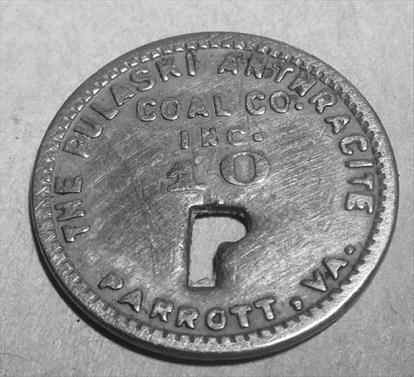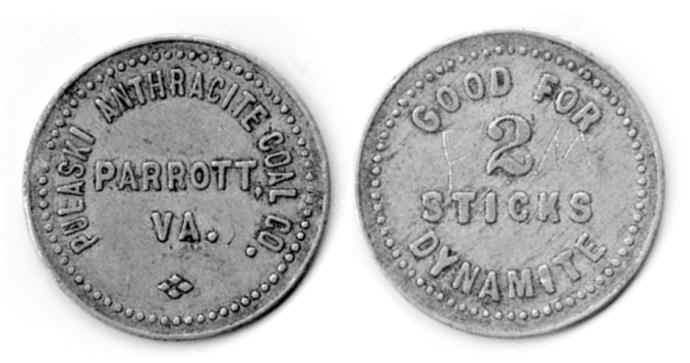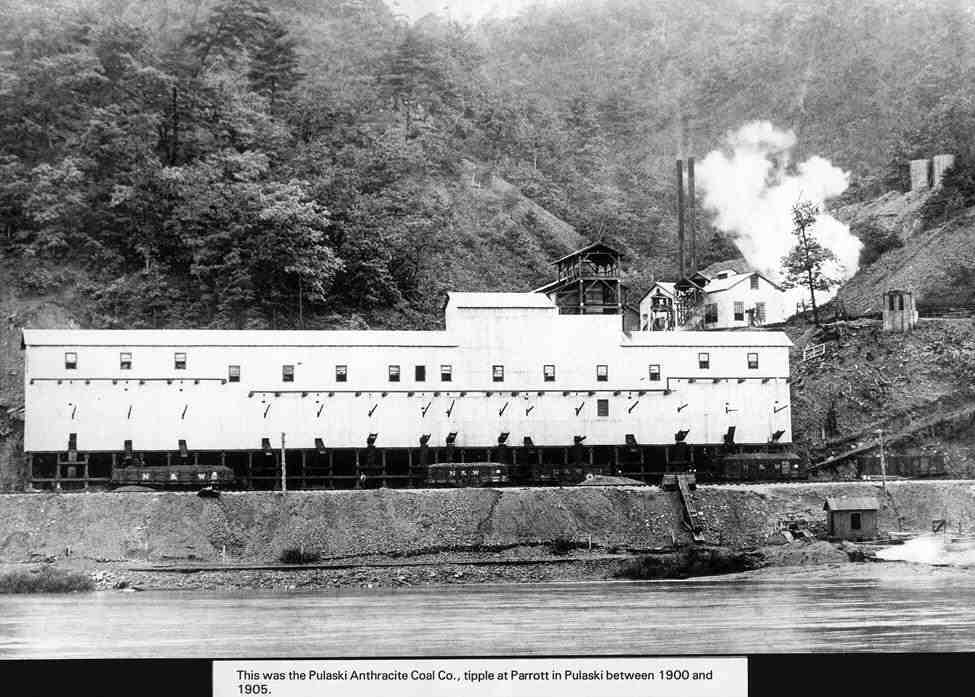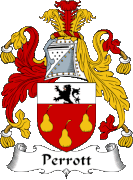Ten cents and two sticks of dynamite: the town of Parrott, Virginia and its namesake, John Henry Parrott
By Wayne Parrott
Chris Perrett recently found a token from Parrott, Virginia, on eBay and posted it on the P-rr-tt Society Facebook page on August 15 of this year (Figure 1). Thus I set out to uncover the story behind the token, which was worth 10 cents at the company store (but worth $81 on Ebay!). It turns out that in remote areas such as mining towns, tokens known as ‘scrip’ were used as currency, given that these locations were too inaccessible for US currency to reach. I have since found another scrip token, worth 2 dynamite sticks (Figure 2).
The town of Parrott is in Pulaski County, and was one of those isolated towns for many years. It is nestled in the Appalachian Mountains in the western part of the state of Virginia. In the last US census, it had all of 435 residents. Although he never lived there, the town was named after John Henry Parrott, Jr. (1847-1930), who started the Pulaski Anthracite Coal Mine there in 1902, and was the mine’s general manager and probable shareholder.
Also known as the Parrott Mine (Figure 3), it was the most prolific mine in the county, and was in operation some 40 years. The mine itself was located on Little Walkers Mountain, and had 130 employees by 1915. It is remembered for having exploded on January 18, 1932. Shortly after the night shift had started, two miners surreptitiously tried smoking 3000 feet underground, causing the mine to explode at 5:30 pm and killing six miners. Eighteen miners survived the explosion, and were described as being so ‘dazed and stupefied by the mad rush over the debris and through the deadly gases in the shaft that they stumbled and fell as they reached the outside.” The bodies of the dead miners were recovered by midnight.

Figure 1 – Ten-cent scrip token found by Chris Perrett on eBay

Figure 2 – another scrip token from the Pulaski Anthracite Coal Co., in Parrott, Virginia, this one for two sticks of dynamite.

Figure 3 – The tipple at the Pulaski Anthracite Coal Co., in Parrott, Virginia. A tipple is a building in which the coal gets loaded onto train cars. Image is used with the permission of the Historical Photograph Collection, Special Collections, University Libraries, Virginia Polytechnic Institute and State University [https://imagebase.lib.vt.edu/view_record.php?URN=lh374&mode=popup]
John Parrott managed other mines as well. Among these were the American Coal Company of Alleghany County, New Jersey, the Pawama Coal and Coke Co. in Matoaka, West Virginia, the Algonquin Coal Co. in Algonquin, West Virginia, and the Deparren Anthracite Coal Co., also headquartered in Parrott, Virginia.
The greatest insight into John Parrott’s lifestyle and personality come from his brushes with the tax collector. In 1925, John Parrott appealed a decision by the Internal Revenue Service, so that he could recover $22,915.25 for taxes he had paid under duress, plus accrued interest on them.
As shown in the appeal transcript, in 1920 John received $10,500 for managing the American Coal Company, and $8,750 for managing the Pawama Coal & Coke Company. His combined income of $19,250 from these two mines would be worth a little over $230,000 at today’s values, or approximately £174,000. The American Coal Co. also gave John a bonus of stocks worth $35,000. John considered this bonus to be a gift, and thus not taxable; the Internal Revenue Service decided it was income, and collected taxes on it accordingly.
John won the appeal, but his tax troubles were not over. In 1924,the US Congress passed the Revenue Act of 1924, which created the Board of Tax Appeals on June 2nd of that year, a year when John had received another $7000 from the American Coal Company. The very first action of the new Board—just 3 months after its creation– was to declare that John’s $7000 did not meet the criteria to be a gift, and were therefore taxable.
John was one of seven children born to John Henry Parrott Sr. (1809-1994) & Elizabeth Elias Edmonds (1811 – 1881) in Virginia. The older John reportedly was educated by private tutors and attended William and Mary College and the University of Virginia. He went on to become a merchant, owning and managing several stores in Virginia.
John Henry Jr. himself spent most of his life as a bachelor. Around the age of 50, he married Josephine Cromwell ca 1896, who was 20 years younger. They had four children, the descendants of which still live in Virginia. Although John Henry Parrott came from a well-to-do family, the family origins are very poorly documented. His great grandfather, John Parrott, was a plantation owner in the 1700’s in King George County, Virginia, and fought in the Revolutionary War (Pension application S 8932). All known descendants of John come from Augustine, his son. An enduring mystery is why Augustine moved to Mathews County, Virginia, as there was another Parrott family there. The move could be entirely coincidental, or it might indicate a relationship between the Parrotts of King George County and those of Matthews County.
For more information on John H. Parrott’s family, see http://tinyurl.com/AugustineParrott
